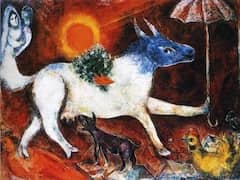The Watering Trough, 1925 by Marc Chagall

Marc Chagall painted The Watering Trough in 1925, in which earlier gouaches with motifs of Russian rural folklore came to hand. The composition of the painting is quite accurately repeated. It shows a peasant woman bending forward in a very expressive pose, rearranging the feeding trough for a droll, distrustful-looking pig. The widespread branches of a tree overshadow the rural scene.
The painting is an example of the new "French" coloring, though raised to the slightly phantasmagorical elevation which is peculiar to Chagall. It is rich but gentle, based on a gently moving modulation of passages of sonorous, adjacent colors. Thus the whole ground of the picture which embraces the scene is a soft dark-blue passage, which begins with the exquisite ultramarine of the feathery, fabulous tree and, passing through the intermittent light of the violet, blends into a nocturnal Prussian blue mingled with slight accents of bluish green. The violet of the ground shows up again in the shaded parts of the peasant woman's garment, becomes stronger in the brown-violet of the trough, and weakens again in the delicate color accents of the fairy-tale bird. The green values culminate in the emerald body of the fabulous pig. The quite abstractly designed white form lights up the entire color sequence with a totally unnatural astral light which responds to the magical tone of the color instrumentation.
Taking account of the colors in this manner, one is surprised to notice that despite the sonorous tone the full range of the color circle has been touched upon: the red and green, the violet and the orange - a pure spot of color showing up on the flank of the swine, which, however unexpectedly from the objective viewpoint, is well-founded in terms of the color scheme. But the loud dialogue of the complementary contrasts has been toned down considerably, and moves into a softly and richly modulated harmony of color.
















